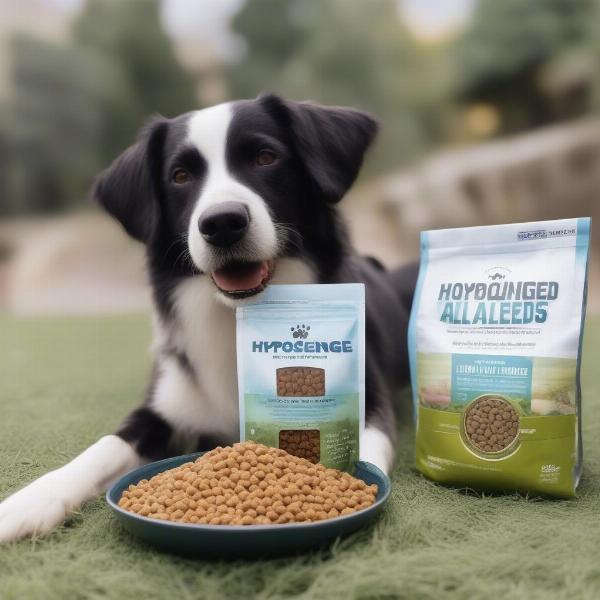Choosing the right food for your small dog can be overwhelming. With so many brands and formulations available, it’s tough to know what’s truly best for your furry friend. This comprehensive guide will delve into the specifics of small dog nutrition, helping you navigate the world of best dog food for small dogs and make an informed decision that supports your pup’s health and happiness.
Understanding Your Small Dog’s Nutritional Needs
Small dogs have unique nutritional requirements compared to their larger counterparts. Their faster metabolisms necessitate a higher calorie intake per pound of body weight. They also have smaller stomachs, requiring more frequent, smaller meals. Look for dog food specifically formulated for small breeds, which typically feature smaller kibble size for easier chewing and digestion. These formulations also often contain higher concentrations of essential nutrients to meet their increased metabolic demands.
Key Nutrients to Look For in the Best Dog Food for Small Dogs
When searching for the best dog food for small dogs, prioritize high-quality protein sources like chicken, lamb, or fish. These provide the building blocks for strong muscles and a healthy coat. Essential fatty acids, like omega-3s and omega-6s, are crucial for skin and coat health, as well as cognitive function. Don’t forget about carbohydrates for energy and fiber for digestive health. Look for whole grains, fruits, and vegetables as excellent sources of these vital nutrients.
Dry vs. Wet Food: Which is Best for Your Small Dog?
Both dry and wet food have their pros and cons. Dry kibble is convenient, shelf-stable, and often more affordable. It also helps clean teeth by scraping away plaque. Wet food, on the other hand, is more palatable for picky eaters and provides higher hydration. Ultimately, the best choice depends on your individual dog’s preferences and needs. You can even combine both dry and wet food for a balanced diet.
Reading Dog Food Labels: Deciphering the Ingredients
Understanding dog food labels is key to choosing the best food for your small dog. The first ingredient listed should be a high-quality protein source. Avoid foods with fillers like corn, wheat, and soy, which offer little nutritional value. Look for the Association of American Feed Control Officials (AAFCO) statement, which ensures the food meets minimum nutritional standards.
What About Grain-Free Dog Food for Small Breeds?
Grain-free diets have gained popularity, but are they necessary? Some dogs have grain allergies, but for most, grains offer beneficial nutrients. Talk to your veterinarian before switching to a grain-free diet, as they can assess your dog’s individual needs and recommend the best course of action. Choosing a grain-inclusive or grain-free diet depends entirely on your dog’s specific health requirements.
Life Stage Considerations: Puppy, Adult, and Senior Dog Food
A puppy’s nutritional needs differ significantly from those of an adult or senior dog. Puppy food is higher in calories and protein to support rapid growth. As your dog ages, their metabolism slows down, requiring a lower calorie diet. Senior dog food is often formulated with joint support supplements to maintain mobility. Always choose a food appropriate for your dog’s life stage.
Common Feeding Mistakes to Avoid
Overfeeding is a common mistake that can lead to obesity in small dogs. Stick to the recommended feeding guidelines on the dog food label and adjust portions based on your dog’s activity level and body condition. Avoid giving your dog table scraps, as many human foods are toxic to dogs.
Best Dog Food for Small Dogs with Allergies
If your small dog has allergies, choose a hypoallergenic or limited ingredient diet. These formulations contain fewer ingredients, making it easier to identify and eliminate allergens. Common allergens include beef, chicken, dairy, and wheat.
 Hypoallergenic Dog Food for Small Dogs
Hypoallergenic Dog Food for Small Dogs
Conclusion
Choosing the best dog food for small dogs is a crucial part of responsible pet ownership. By understanding your dog’s specific needs and following the guidelines in this article, you can make an informed decision that supports their overall health and well-being. Remember, consulting with your veterinarian is always recommended for personalized dietary advice tailored to your small dog’s unique requirements.
FAQ
- How often should I feed my small dog? Most small dogs benefit from two to three small meals per day.
- What are the signs of a food allergy in my dog? Common signs include itching, skin irritation, gastrointestinal upset, and ear infections.
- Can I give my small dog treats? Yes, but treats should not exceed 10% of their daily caloric intake.
- Is it okay to switch dog food brands? Yes, but do so gradually to avoid digestive upset.
- How do I know if my dog is overweight? You should be able to feel your dog’s ribs without pressing too hard. If you can’t, they may be overweight.
- What should I do if my dog refuses to eat their new food? Try mixing the new food with their old food gradually.
- How do I store dry dog food? Store it in a cool, dry place in an airtight container.
Related Articles on ILM Dog
About ILM Dog
ILM Dog is your trusted source for expert advice on all things dog-related. We offer comprehensive resources on dog breeds, health, training, nutrition, grooming, and much more. Our goal is to empower dog owners worldwide with the knowledge and tools they need to provide the best possible care for their canine companions. Taiga Dog Food provides balanced nutrition for your pets. Contact us at [email protected] or +44 20-3965-8624 for personalized guidance.